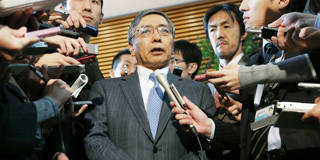When Japanese Prime Minister Shinzo Abe appointed Haruhiko Kuroda as governor of the Bank of Japan in 2013, the country had been living with deflation for 15 years. Kuroda may not have achieved the BOJ’s target of 2% inflation, but that was never his only goal.
TOKYO – In December 2012, Japanese voters brought the Liberal Democratic Party (LDP) and its leader, Shinzo Abe, to power after three chaotic years of rule by the Democratic Party of Japan (DPJ). Abe himself assumed the premiership for the second time, having headed the government from September 2006 to September 2007. And in January 2013, a month after taking office, he announced a broad economic-policy package that would come to be known as Abenomics.

TOKYO – In December 2012, Japanese voters brought the Liberal Democratic Party (LDP) and its leader, Shinzo Abe, to power after three chaotic years of rule by the Democratic Party of Japan (DPJ). Abe himself assumed the premiership for the second time, having headed the government from September 2006 to September 2007. And in January 2013, a month after taking office, he announced a broad economic-policy package that would come to be known as Abenomics.